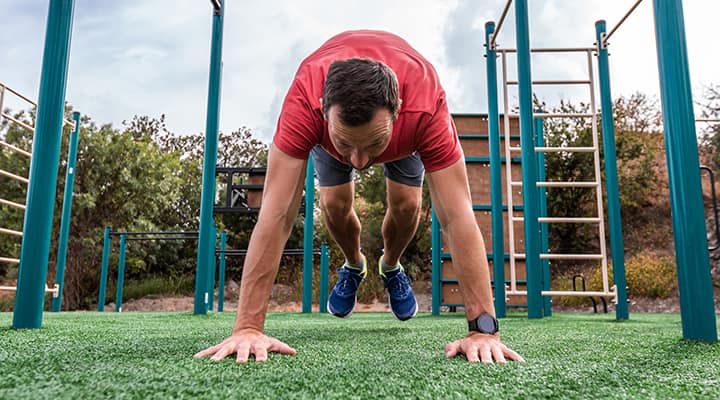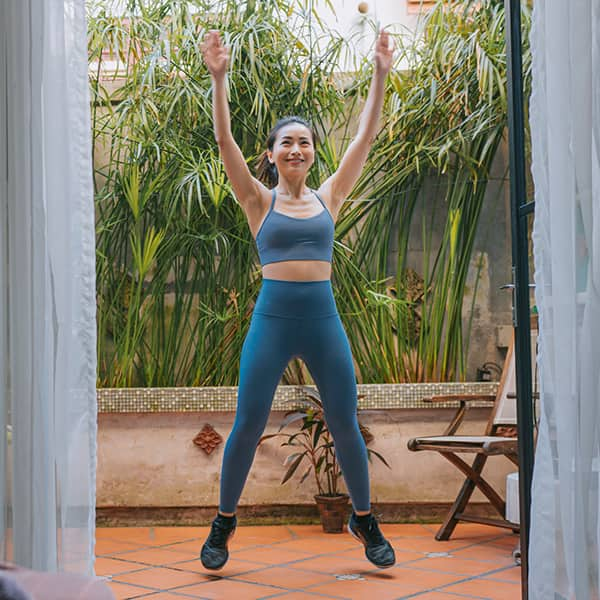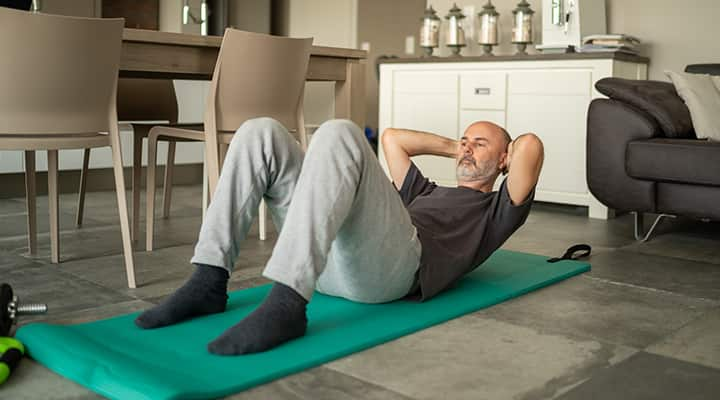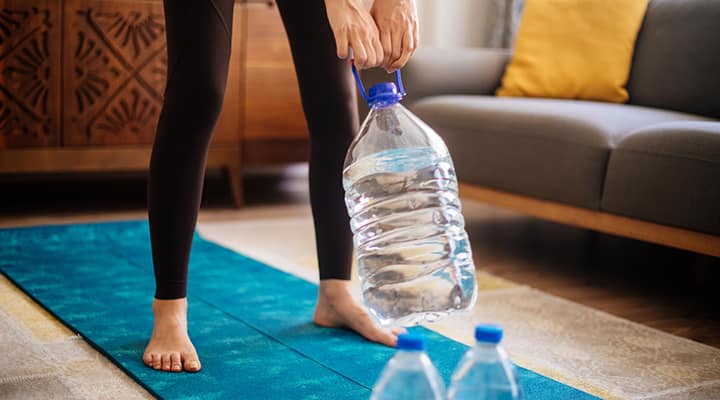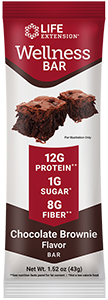
Micro Workouts: How a Little Exercise Can Make a Big Difference
Published: May 2024
Unfortunately, it's true: maintaining muscle strength and function doesn't get any easier with age. But it's also not nearly as hard as most people make it out to be. All you really need is a five-minute workout.
Seriously! Micro workouts—which last about 5 to 10 minutes—can offer the same health benefits as long, intense training sessions. Not to mention, these workout "snacks" make exercise more accessible to all ages and fitness levels.
Just about anyone can handle short bursts of heart-pumping activity. You just need to know how to maximize every minute so you're not wasting precious time.
What are micro workouts?
Micro workouts are defined as physical activity that can be performed in 5 to 10 minutes and are meant to be repeated three to five times a day, adding up to the length of a longer workout.
While the Department of Health and Human Services recommends getting at least 150 minutes of moderate-intensity (or 75 to 150 minutes of vigorous-intensity) aerobic activity and two days of muscle-strengthening activity per week, that can be tough when you're short on time. Micro workouts can help fill in those gaps.
Ideally, micro workouts are high-intensity activities, where each exercise is intended to be performed in one minute or less.
How long is a micro workout?
You can make a micro workout as short as 20 seconds or as long as 10 minutes. The duration depends on your availability and your goals. The minimal time commitment is what makes these workouts such a practical tool for staying fit, especially for:
- People who work long hours and can't get away from their office
- Shift workers who work odd hours or overnight, when the gym is closed
- Frequent travelers who have inconsistent or unpredictable access to fitness facilities
- New parents who only have a few minutes to spare during naptime
- Exercise newbies, trying to gradually increase their activity level
- Anyone with busy schedules or an on-the-go lifestyle
6 benefits of micro workouts
There is an abundant body of research about the numerous health benefits of regular exercise. And, yes, even short workouts can have big effects on your health in major ways:
1. Weight management
Your body weight is determined by your energy balance, a combination of the energy you expend and the energy you consume. Your diet influences how much energy you consume each day, whereas, total daily energy expenditure is influenced by four main components: basal metabolic rate (BMR), non-exercise activity thermogenesis (NEAT), exercise activity thermogenesis (EAT) and thermic effect of food (TEF). Exercise activity thermogenesis accounts for 15-30% of total daily energy expenditure.
Therefore, any amount of time you spend exercising can help increase your overall calorie burn, with the National Academy of Sports Medicine even touting that as little as 100 calories each day translates to approximately 10 lbs. lost in a year.
2. Mood and cognitive function
Have you ever felt an endorphin rush? Endorphins are considered one of the "happy hormones" produced in the brain. They contribute to a positive mindset and a euphoric sense of accomplishment. You might experience this wave of emotion after an aerobic workout.
Exercise may also improve memory, attention, processing speed and even the ability to retrieve information you've stored in the back of your mind.
3. Immune health
Having a regular aerobic and strength-training workout routine has long been associated with a strong immune system. But now there's evidence to suggest micro-exercise offers the same benefits. A large-scale Danish study found that engaging in workplace-based micro-exercise during work hours led to more workers staying well and fewer work absences.
Now you don't have to feel guilty for taking five-minute breaks at work—just be sure you're moving for those five minutes. It'll do your body good—and keep your boss off your back.
4. Cardiovascular health and endurance
Cardiovascular endurance refers to how well and for how long your heart and lungs can supply oxygen to your body during exercise. This is typically quantified by a person's maximum rate of oxygen uptake, commonly known as VO2 max.
If you've heard of the Tabata workout method, then you already know that short, high-intensity exercise can significantly increase VO2 max. And science continues to back that up. Research shows that a 30-minute aerobic workout, consisting of a warmup, a cooldown and three 20-second sprint intervals with 2-minute recovery periods in between repeated three times on non-consecutive days of the week, led to a 12% increase in VO2 max and better overall endurance. This same training protocol also supported the participants' healthy blood pressure.
5. Healthy aging
Do you want to live better for longer? Of course, you do. Well, running is a good place to start. Running even 5-10 minutes per day at a slow and steady speed (less than 6 mph) was associated with healthy aging. The large observational study says, "Compared to nonrunners, runners had a 3-year life expectancy benefit." In other words, you could gain three years by simply lacing up your shoes for five minutes a day.
Don't fret if running isn't your thing, though. It is well known that VO2 max is a strong predictor of overall lifespan, and there are a number of ways you can increase your own VO2 max. All you need is a minimum of three minutes of high-intensity activity per week.
6. Efficient and economical
Efficient and economical may not be health benefits, per se, but they can indirectly reduce stress by saving you time and money. Micro workouts can be done anytime, anywhere, which means you don't need a gym membership or fancy equipment.
You also don't need to carve out an hour in your day by sacrificing sleep in the morning or your lunch break in the afternoon. Micro workouts are like exercise "snacks." Here and there, you take a quick bite, and then go about your day.
Explore Our Best Active Lifestyle & Fitness Supplements
13 micro workout exercises
By now, hopefully, you're motivated to try one of these micro workouts. There are endless exercise options from which to choose. Some are better than others, though. These 13 are the best for a quick workout that increases your heart rate while building muscular strength and endurance.
1. Burpees
Start standing with feet hip-distance apart. Squat down and place hands on the floor in front of you. Jump your feet backward, landing in a high-plank position. Jump or step feet forward, landing in a deep squat. Stand up or jump to reset.
2. Push-ups
Start on the floor, with hands stacked directly under your shoulders and toes on the ground, about hip-distance apart. Keep shoulders and hips level, like you're trying to balance a glass of water on your back. Bending from your elbows, drop your chest toward the floor. Make sure your hips go down with you. Press into your hands to reset at the top.
Pro tip: Increase the intensity with power push-ups. Forcefully press into your hands, so they rapidly come off the floor when you push up.
3. Squats
Stand with feet hip-distance apart. Bend from the knees to drop your hips toward the floor while keeping your chest pushed out. Drive up through your feet to stand up and reset.
4. Pull-ups
Locate a secure bar and grab hold. Using your back and arm muscles, pull your chest toward the bar, aiming to get your chin above it. With control, straighten arms and lower down to reset.
5. Lunges
Start standing with feet hip-distance apart. For front lunges, step one foot forward, keeping feet hip-distance apart. Bend from the knees to drop hips toward the floor. Your back heel will come off the ground. From the bottom, drive up through the front foot and back toes to stand up and reset with both feet next to each other.
You can also try different variations on lunges, including front, reverse, lateral, swing, curtsy and walking.
6. Jumping jacks
Start standing with arms by your side. As you jump with your feet out wide, raise your arms up overhead. Now, simultaneously, lower your arms and jump feet back together to reset. You can also do these without jumping. Instead, step your feet out and back in, one foot at a time to lessen the impact.
7. Jumping knee tucks
Start standing. Bend knees slightly to get into a quarter-depth squat and load your legs like a spring. Quickly, jump off the ground, while pulling your knees into your chest. Try to control how hard your feet land on the ground.
8. Thrusters
Start standing with a dumbbell in each hand. Bring dumbbells to the top of your shoulders. Sit hips back and down into a squat position. Drive up through your feet and stand up, as you punch the dumbbells to the sky. Use the power in your legs to help get the weight overhead. Lower dumbbells to your shoulders to reset.
9. Hip-hinge swings
Using both hands, hold a dumbbell, kettlebell or other weighted item in the middle of your hips. Shift hips backward with a slight bend in your knees. Quickly shift hips forward, forcing the weight to float up and out in front of you. The weight should reach about chest height. Let the weight float back down. Once it reaches your belly button, start to shift hips back again to link your reps together.
10. Gorilla rows
Start in a tabletop position, with hands on the ground directly underneath your shoulders and knees bent directly underneath your hips. Come up onto your toes, so knees are hovering about an inch off the ground. Use your right arm to grab a weight and pull it back toward your right hip. Repeat on the other side.
11. Sit-ups
Lie on the ground with knees bent and feet flat on the floor. Place arms across your chest or behind your head with elbows wide. Use your abdominal muscles to bring your chest toward your knees and lower back off the ground. Slowly lower down to reset.
12. Step-ups
Stand in front of a bench, chair, staircase or step riser. Place right foot on the step and allow the left foot to follow. Keeping the right foot on the step, lower left foot back down. Either keep the right foot in place and repeat reps or completely reset with both feet on the ground.
13. Running in place
Start standing and drive your knees up toward your hips, while pumping your opposite arm. Make sure to quickly exchange feet and arms to elevate your heart rate.
How to create your own routine
Establish your fitness goal—Do you need more cardio exercise or more strength training? Do you want to focus on upper body, lower body, core or hit everything at once? The answers to these questions will guide your exercise choices.
If you're already in a consistent training routine, consider how these short rounds fit in the big picture and try to avoid too much overlap in exercise type.
Gather your gear—Assess what equipment and space you have to use for your workouts. If you'll be working out in different spaces at different times, consider using resistance bands—a very portable tool that can make a simple biceps curl burn like it never has before.
Other accessories you might want to grab: a mat, medicine ball, step risers and a bench. You may need to get creative with your space. For instance, a desk chair can easily double as a bench and a one-gallon water bottle or large purse can substitute for a dumbbell or medicine ball.
Play with different planes of motion—You move in different planes of motion through everyday life, so make sure your workouts do the same. This will train your muscles (and mind!) to move in all directions.
No matter what format you pick, try to include exercises that take you forward, backward, side-to-side or make you rotate your spine. You don't have to work all planes of motions in one micro workout, but you should cover them throughout one day, or at least one week.
Set a time slot—Determine how much time you have to allocate. It could be 3 minutes, 6-1/2 minutes or 10 minutes. The exact amount doesn't matter. The point is to make your micro workouts fit into your schedule—not the other way around. The only caveat is to not spend more than 10 minutes in a micro workout, or you'll likely compromise intensity. These should be short and powerful exercises.
Pick a format—Micro workouts can be structured like HIIT workouts. The most common formats are AMRAP (as many reps as possible in a certain amount of time) and EMOM (every minute on the minute you do a certain number of reps). You can also do traditional sprint intervals with cardio equipment or with explosive bodyweight movements. These would look like 30 seconds of hard work, followed by 30 seconds of rest. Rinse and repeat three times, or for up to 10 rounds.
Pro tip: Lost for ideas? Start with something simple, like EMOM for 5 minutes, three exercises for three rounds, or running in place as fast as you can for a certain number of rounds.
Get moving—Now you have everything you need to add micro workouts to your day. Like with any new exercise program, make sure a healthcare professional clears you for physical activity before you begin. Also, don't forget to fuel your body. These may be exercise "snacks," but they quickly add up to a complete workout that requires proper food, hydration and recovery support.
Take our health quiz if you need help finding the right nutrition for your fitness goals. Most importantly, have fun with your micro workouts! They may be the best minutes of your day.
References
- Andersen LL, et al. "Potential of micro-exercise to prevent long-term sickness absence in the general working population: prospective cohort study with register follow-up." Sci Rep. February 2022. https://pubmed.ncbi.nlm.nih.gov/35145176/
- Aragon AA, et al. "International society of sports nutrition position stand: diets and body composition. J Int Soc Sports Nutr." June 2017. https://jissn.biomedcentral.com/articles/10.1186/s12970-017-0174-y
- Comana F. "Non-Exercise Activity Thermogenesis: A NEAT Approach to Weight Loss." National Academy of Sports Medicine. https://blog.nasm.org/exercise-programming/neat-approach-weight-loss
- Gillen JB, et al. "Three minutes of all-out intermittent exercise per week increases skeletal muscle oxidative capacity and improves cardiometabolic health." PLoS One. November 2014. https://www.ncbi.nlm.nih.gov/pmc/articles/PMC4218754/
- Lee DC, et al. "Leisure-time running reduces all-cause and cardiovascular mortality risk." J Am Coll Cardiol. August 2014. https://pubmed.ncbi.nlm.nih.gov/25082581/
- U.S. Department of Health and Human Services. Physical Activity Guidelines for Americans, 2nd edition. Washington, D.C. 2018. https://health.gov/sites/default/files/2019-09/Physical_Activity_Guidelines_2nd_edition.pdf
Like what you read?
Please subscribe to get email updates on this blog.





